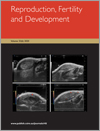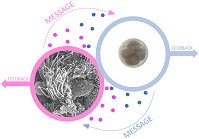Early embryo survival and successful implantation are of obvious fundamental importance in establishing a pregnancy in cattle, yet have received surprisingly little attention. A comprehensive review of the literature has identified early development of ovarian follicles and the first 3 weeks of embryo development as critical periods that determine reproductive success. A deeper understanding of these critical periods in female reproductive biology will inform the next step change in improving the efficiency of natural and assisted reproduction in cattle.

Reproduction, Fertility and Development
Volume 32 Number 6 2020
RD19019Altered embryotrophic capacities of the bovine oviduct under elevated free fatty acid conditions: an in vitro embryo–oviduct co-culture model
 , V. van Hoeck, I. Pintelon, S. Thys, P. E. J. Bols, W. F. A. Marei and J. L. M. R. Leroy
, V. van Hoeck, I. Pintelon, S. Thys, P. E. J. Bols, W. F. A. Marei and J. L. M. R. Leroy
Upregulated lipolysis is commonly associated with metabolic disorders and deleterious effects on female fertility. The role of the oviduct in this process remains insufficiently investigated due to complicating factors such as multiple-metabolite interactions and difficult organ accessibility. Our in vitro results suggest a direct embryotoxicity induced by elevated concentrations of non-esterified fatty acids within the earliest embryonic environment, through a reduced oviductal ability to support and protect early embryo development.
RD19360Asynchrony between the early embryo and the reproductive tract affects subsequent embryo development in cattle
 , Meriem Hamdi, Michael McDonald, Vitezslav Havlicek, Urban Besenfelder, Patrick Lonergan and Dimitrios Rizos
, Meriem Hamdi, Michael McDonald, Vitezslav Havlicek, Urban Besenfelder, Patrick Lonergan and Dimitrios Rizos 

This study aimed to determine the effect of asynchrony between embryo age and female reproductive tract cycle stage on subsequent embryo development in cattle. Transfer of embryos to an oviduct 2 days in advance of the embryo reduced embryo development on Days 4, 7 and 15. Accelerated conceptus development at Day 15 was likely due to effects of progesterone on the endometrium. The results highlight the importance of synchrony between the embryo and the oviduct and uterus in establishing pregnancy.
RD19085Analysis of the uterine flush fluid proteome of healthy mares and mares with endometritis or fibrotic endometrial degeneration
 , Firdous A. Khan, Tracey S. Chenier, Elizabeth L. Scholtz and M. Anthony Hayes
, Firdous A. Khan, Tracey S. Chenier, Elizabeth L. Scholtz and M. Anthony Hayes
The uterine environment is paramount to fertility, yet little is known about uterine proteomic differences between mares with a healthy uterus and mares with uterine disease. This study demonstrated qualitative and quantitative differences between healthy mares and mares with endometritis or fibrotic endometrial degeneration. The results can serve as a basis for finding specific biomarkers of uterine health and disease.

MicroRNAs (miRNAs) are essential for testicular development and spermatogenesis. Using small RNA sequencing technology, 531 mature miRNAs were identified in Mongolian horse testes, among which 107 miRNAs were differentially expressed between immature and mature testes. These findings identify miRNAs as key factors in the development of the testes and spermatogenesis in the Mongolian horse.
We have previously shown that implantation of dissociated neonatal pig testis cells under the back skin of immunodeficient mice can lead to regeneration of functional testis tissue, although the results were inconsistent and inefficient. Here, by examining several factors, we dramatically improved the consistency, efficiency and predictability of the model. The testis cell implantation model can be used as an accessible system to study and manipulate testis tissue development and regeneration, and as a unique model for fertility preservation of prepubertal boys undergoing gonadotoxic cancer treatments.
RD19024Opposite effects of high- and low-dose di-(2-ethylhexyl) phthalate (DEHP) exposure on puberty onset, oestrous cycle regularity and hypothalamic kisspeptin expression in female rats
 and Junping Wen
and Junping Wen

Di-(2-ethylhexyl) phthalate (DEHP) is ubiquitous in the environment. This study found that low and high doses of DEHP had opposite effects on female puberty onset, hypothalamic kisspeptin expression and reproductive hormones. These results contribute to the comprehensive evaluation of DEHP toxicity on the human reproductive system.
Seminal plasma, the fluid that, together with sperm cells, makes up the semen, contains antioxidant enzymes. This study investigated whether seminal plasma is able to counteract induced oxidative stress in donkey spermatozoa. Following induction of oxidative stress with exogenous hydrogen peroxide, we observed that seminal plasma has a limited effect in modulating the response of donkey spermatozoa to that stress.
RD19164Effects of the environmental endocrine disruptors di-2-ethylhexyl phthalate and mono-2-ethylhexyl phthalate on human sperm function in vitro

Di-2-ethylhexyl phthalate (DEHP) is the most widely used plasticiser and human exposure to DEHP is ubiquitous in daily life. We found that DEHP had no effect on human sperm function at the doses that cover the concentrations detected in human semen, but that mono-2-ethylhexyl phthalate (the main metabolite of DEHP) affected human sperm function by increasing sperm [Ca2+]i and tyrosine phosphorylation. These data add to our understanding of the effects of DEHP on male reproduction.



